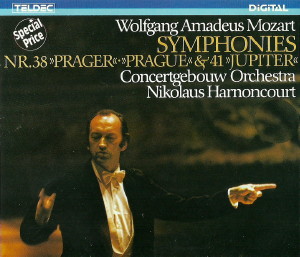 |
1 LP -
6.42805 AZ - (p) 1982
|
 |
| 2 CD -
8.48219 ZL - (c) 1985 |
|
| Wolfgang Amadeus
Mozart (1756-1791) |
|
|
|
|
|
|
|
| Symphonie Nr. 38 D-dur,
KV 504 "Prager" |
|
38' 15" |
|
- Adagio - Allegro
|
19' 25" |
|
A |
| - Andante |
11' 00" |
|
B1 |
| - Finale: Presto |
7' 50" |
|
B2 |
|
|
|
|
| CONCERTGEBOUW ORCHESTRA,
AMSTERDAM |
|
| Nikolaus
Harnoncourt, Dirigent |
|
|
Luogo
e data di registrazione
|
| Concertgebouw,
Amsterdam (Olanda) - settembre 1981 |
|
Registrazione
live / studio
|
| studio |
Producer
/ Engineer
|
-
|
Prima Edizione CD
|
| Teldec
- 8.48219 ZL - (2 cd) - 38' 15" + 41'
24" - (c) 1985 - DDD |
Prima
Edizione LP
|
Telefunken - 6.42805
AZ - (1 lp) - 38'
15"
- (p) 1982 - Digital
|
|
|
Notes
|
Hans Georg Nägeli (l773-1836), a highly
respected composer. choirmaster,
teacher, publisher and musicologist
in his native Switzerland, was one of the first contemporary
critics to examine Mozart's oeuvre
(in his "Vorlesungen über Musik", 1826).
Starting hom the premise that the
correctly used form was og greater
importance in music than the content
and emotional value ol a
composition, he arrived at aesthetic judgements that seem
strange to us today, but were shared
by many of his
generation. In
fact, his statement
that "the artistic
process of
contrast" was the most prominent
feature of Mozart's instrumental
music is still accepted today. But
the evaluations that Nägeli drew from this
characterization are fundamentally
at variance with our own. For him,
the combination of “instrumental
and non-instrumental"
was sheer "stylistic nonsense" which
bore all the "signs of a distasteful
lack of style" and was typical of
"Mozart's character and way of life:
he was too impetuous, it not
flippant, and composed as he was."
What Nägeli
criticised in a rare mixture of musical and moral
viewpoints as “a genius’s flaw" because
"Mozart ignores the beauty of proportion
between the parts of a work of art"
is perceived today to be one of the
greatest merits of Mozart`s music. Its universality
lies not only in Mozart`s
inventiveness and the beauty of his
inspiration, but above all in his
ability to achieve effects by
contrast. Nor is his use of contrast
restricted to the alternation of
cantabile and instrumental passages
- it extends to every dimension of
his music: in his compositional
technique he "is master of the
succession of passages and subjects,
of the relationship between main and
subsidiary phrase, of the
alternation of homophony and
counterpoint. of the theory of
dynamics, the distribution of light
and shadow and the principles of
instrumentation. Mozart has an
inexhaustible talent for juxtaposing
opposites in the most diverse ways,
and an astounding ability to hold
everything in balance, in an
equilibrium that makes the sequence
of ideas seem the only logical one"
(Floros).
Mozart’s ‘Prague' Symphony K. 504,
which he completed on 6th December
1786 and premiered before a Prague
intoxicated with "Figaro"
on 18th January 1787, must be
counted among the symbols of this
artistic dexterity.
One of the work‘s main
characteristics - alongside its
symphonic gravity, its intellectual
concentration and its etnotional
maturity and introspectiveness - is
not least its perfect synthesis of a
highly developed instrumental style
animated by counterpoint with the
compelling melodies of a stage work.
Without turning into quotations,
several rhythmic and melodic
reminiscences recall ,Figaro’ and
,Don Giovanni‘. The ,ducal`
atmosphere of the latter is recalled
by the repeated alternation of forte
and piano in the expansive, agonized
adagio introduction; in the second
movement the second subject varies
those motifs that characterize the
duet between Don Giovanni and
Zerlina (“Andiam, andiam, mio
bene"), while in the finale there is
presumably more than a chance
resemblance between the first”
subject of the presto and the duet
“Aprite, presto aprite" from Act II of
,Figaro’. Whether the lack of a
minuet is to be attributed to the
nature of the music (Einstein: “In
three movements, everything that
needs to be said is said") remains
uncertain: the fact that Mozart
failed to compose a dance movement subsequantly mau also
indicate that the symphony was not
performed in Vienna. There it was
an unwritten rule that a symphony
had four movements.
Uwe Kraemer
Translation: Clive R. Williams
|
|
Nikolaus
Harnoncourt (1929-2016)
|

|

|
|